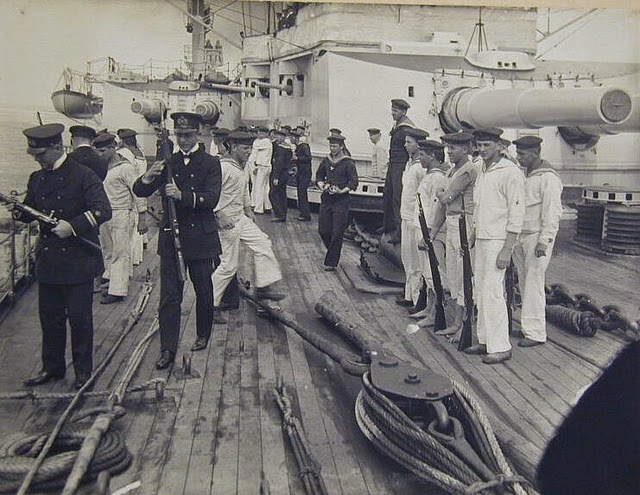Now we talking About SMS Nassau. SMS can mean Ser Majesty Ship in English if you already now about this well good then.
SMS Nassau
Not until the Braunschweig class, built between 1901 and 1906, did the German produce a first-class battleship comparable with those build aboard. These where followed by slightly improved version, the Deutschlands, built between 1903 and 1908. when the British battleship Dreadnought appeared, the German designers were not ready to build a comparable vessel. Their first all-big-gun ship, the Nassaus, were not laid down until nine months after Dreadnought had been completed, and were simple enlarged Deutschland. They use slightly more powerful version of the Deutschland reciprocating machinery, and this prevented turrets being mounted in the center of the ship as in turbine-powered Dreadnought. The Nassaus therefore adopted the very wasteful arrangement of four wing turrets, and they retained the Deutschland's 11 inch (280mm) gun. The German preferred to use a small shell with high muzzle-velocity. The weight saved by not using a larger calibre gun was utilised to improve the protection. in this respect the Nassaus were superior to their British contemporaries, though as with most ship with wing turrets, these were very close to the side of the ships. The layout of the wing turrets magazine was very cramped. Unlike the British the German retained a heavy calibre secondary armament, because they considered, wrongly as it turned on, that most battle in the North sea would take place at ranges where the secondary armament could play a significant part. These guns also doubled as a defence against destroyers which the German, again unlike the British considered to be primarily the responsibility of the battleship rrather than the escorting destroyers . the 5.9 inch (150mm) guns were well placed,but the 3.4 inch (88mm) guns at the bow and stern were poorly positioned. The wide beam and heavy turrets near the ship sides meant a large metacentric height. this ought to have given a steady gun platform on the North Sea, but unfortunately an oversight resulted in their period of roll coinciding with that of an average North Sea swell. This was discovered in the initial sea trials, and the class were hastily fitted with bilge keels in an attempt to eliminate this undersirable feature. In any case, they would have been very poor gun platform in the longer Atlantic swell. The next German battleship the four Helgolands, were enlarged and improved Nassaus, with twelve 12 inch (305mm) guns on a larger hull. the boilers were grouped together, allowing the wings turret to be moved further inboard, but the same wasteful turret arrangement was adopted,and because German manufactures could not build turbines require time, reciprocating engines were retained Westfalen, Rheinland and Posen had simmiliar careers to Nassau, and the first two were slightly damaged at the battle of Jutland (31 May 1916). Westafalen was hit by torpedo from the British submarine E-23, on 19 August 1916 and was under repair until October 1916. Rheinland damaged her hull after Running aground off the Finnish coast on 11 April 1918. She as toed to Kiel but was not repaired because steel supply is running low.
Displacement: Nassau as built
normal tons (tonnes) 18,900 (19,200)
full load tons (tonnes) 20,210 (20,530)
Dimension
lenght (wl) 477.7 ft (145.6m)
(oa) 479.3ft (146.1m)
beam 88.3ft (26.9m)
draught 27.9ft (8.5m)
Armament as built
guns
11 inch (280mm) 45 Cal 12
5.9 inch(150mm)45 Cal 12
3.4 inch(88mm) 16
torpedo tubes
17.7 inch (450mm) 6
Armour
side (belt) 3.9-11.5 inch (100-300 mm)
armour deck 2.2-3.9 inch (55-100 mm)
main turrets 3.5-11 inch (90-280 mm)
barbettes 11 inch (280 mm)
Machinery
boiler (type) Naval
(number) 12
engines (type) vertical triple expansion
shaft 3
Total SHP
designed 22,000
trials 26,244
Fuel capacity
coal, normal tons (tonnes) 940 (950)
max tons (tonnes) 2,950 (3,000)
Performance
designed speed 19,5 knots
trial speed 20 knot
range 9,400 miles (7,900 nm) @10 knots
Crew 963
Service career NASSAU
1910-1918 1st Battle squadron, High Seas Fleet
1914 (Aug- May 1916) Sorties with high Seas Fleet
1915 Two stern 3.4 inch (88mm) guns removed
1916 (31 May) Battle of Jutland: Hit by two medium shells, and collided with British destroyer Spitfire during night action
1916 (June-10 July) Repaired
1916 (Aug-April 1918) Three Sorties in North Sea with High Seas Fleet
1916-1917 Remaining 3.4 inch (88mm) guns removed, four 3.4 inch (88mm) anti-aircraft guns mounted
1919 (5 Nov) Stricken
1920 (7 April) transferred to japan and sold for scrap
1924 Scrapped
Ship: NASSAU WESTFALLEN RHEINLAND POSEN
built: Wilhelmshaven Weser,Bremen Vulcan,Stettin Germania,Kiel
Dockyard
Authorised: 1907 1907 1907 1907
Laid down: 22 July 1907 12 Aug 1907 1 June 1907 11 June 1907
Launched: 7 March 1908 1 July 1908 26 Sept 1908 12 Dec 1908
Completed: Oct 1909 Nov 1909 April 1910 May 1910
Fate: Scrapped 1924 Scrapped 1924 Scrapped 1922 Scrapped 1921





Tidak ada komentar:
Posting Komentar